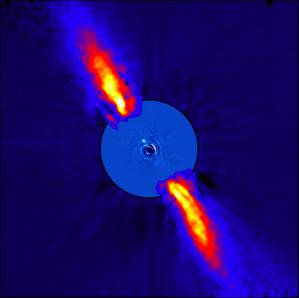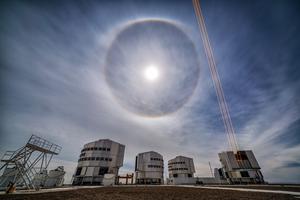Glossary term: 自適應光學
Description: 夜晚抬頭仰望,你可能會看到恆星在閃爍。大氣中的空氣總是在運動,當恆星發出的光經過有湍流的區域時,會發生不同程度的偏轉。因此,我們在天空中看到的每顆恆星並不是穩定的單個光點,而是跳躍、不斷變化、扭曲的一連串光點。這樣的閃爍使得天文學家無法以大型地面望遠鏡本應達到的水平拍攝到天體的詳細圖像。自適應光學是減輕這種效應的一種方法。自適應光學(AO)系統利用真實的恆星或是激光投射的“人造恆星”,實時監測大氣畸變。進入望遠鏡的光線被引導到一面可變形的鏡子上。在計算機的控制下,鏡面以適當的方式不斷變形,以抵消大氣畸變的影響。
Related Terms:
See this term in other languages
Term and definition status: The original definition of this term in English have been approved by a research astronomer and a teacher The translation of this term and its definition is still awaiting approval
This is an automated transliteration of the simplified Chinese translation of this term
The OAE Multilingual Glossary is a project of the IAU Office of Astronomy for Education (OAE) in collaboration with the IAU Office of Astronomy Outreach (OAO). The terms and definitions were chosen, written and reviewed by a collective effort from the OAE, the OAE Centers and Nodes, the OAE National Astronomy Education Coordinators (NAECs) and other volunteers. You can find a full list of credits here. All glossary terms and their definitions are released under a Creative Commons CC BY-4.0 license and should be credited to "IAU OAE".
If you notice a factual or translation error in this glossary term or definition then please get in touch.
Related Media
老人增四b
Credit: ESO/A.-M. Lagrange et al. credit link
License: CC-BY-4.0 Creative Commons 姓名標示 4.0 國際 (CC BY 4.0) icons
位於帕拉納爾天文臺的歐洲南方天文臺甚大望遠鏡與月暈
Credit: 胡安-卡洛斯-穆尼奧斯-馬特奧斯/歐空局 credit link
License: CC-BY-4.0 Creative Commons 姓名標示 4.0 國際 (CC BY 4.0) icons










